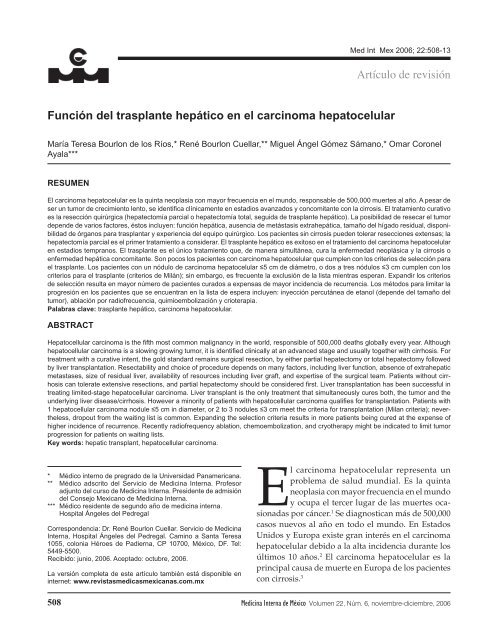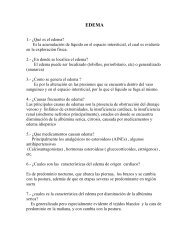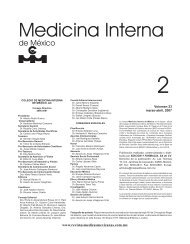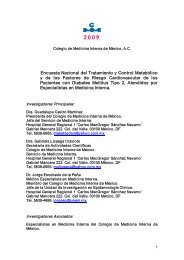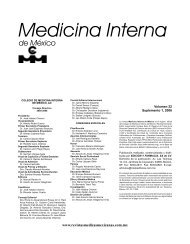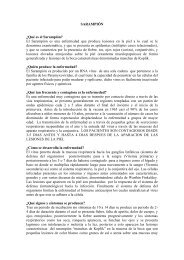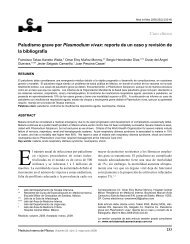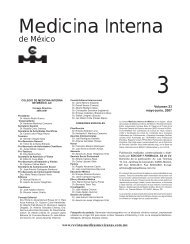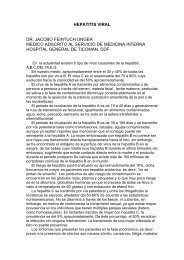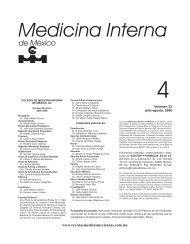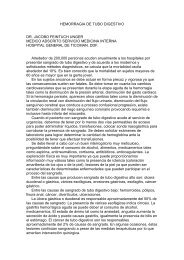Noviembre-Diciembre - Colegio de Medicina Interna de México
Noviembre-Diciembre - Colegio de Medicina Interna de México
Noviembre-Diciembre - Colegio de Medicina Interna de México
You also want an ePaper? Increase the reach of your titles
YUMPU automatically turns print PDFs into web optimized ePapers that Google loves.
Med Int Mex 2006; 22:508-13Artículo <strong>de</strong> revisiónFunción <strong>de</strong>l trasplante hepático en el carcinoma hepatocelularMaría Teresa Bourlon <strong>de</strong> los Ríos,* René Bourlon Cuellar,** Miguel Ángel Gómez Sámano,* Omar CoronelAyala***RESUMENEl carcinoma hepatocelular es la quinta neoplasia con mayor frecuencia en el mundo, responsable <strong>de</strong> 500,000 muertes al año. A pesar <strong>de</strong>ser un tumor <strong>de</strong> crecimiento lento, se i<strong>de</strong>ntifi ca clínicamente en estadios avanzados y concomitante con la cirrosis. El tratamiento curativoes la resección quirúrgica (hepatectomía parcial o hepatectomía total, seguida <strong>de</strong> trasplante hepático). La posibilidad <strong>de</strong> resecar el tumor<strong>de</strong>pen<strong>de</strong> <strong>de</strong> varios factores, éstos incluyen: función hepática, ausencia <strong>de</strong> metástasis extrahepática, tamaño <strong>de</strong>l hígado residual, disponibilidad<strong>de</strong> órganos para trasplantar y experiencia <strong>de</strong>l equipo quirúrgico. Los pacientes sin cirrosis pue<strong>de</strong>n tolerar resecciones extensas; lahepatectomía parcial es el primer tratamiento a consi<strong>de</strong>rar. El trasplante hepático es exitoso en el tratamiento <strong>de</strong>l carcinoma hepatocelularen estadios tempranos. El trasplante es el único tratamiento que, <strong>de</strong> manera simultánea, cura la enfermedad neoplásica y la cirrosis oenfermedad hepática concomitante. Son pocos los pacientes con carcinoma hepatocelular que cumplen con los criterios <strong>de</strong> selección parael trasplante. Los pacientes con un nódulo <strong>de</strong> carcinoma hepatocelular ≤5 cm <strong>de</strong> diámetro, o dos a tres nódulos ≤3 cm cumplen con loscriterios para el trasplante (criterios <strong>de</strong> Milán); sin embargo, es frecuente la exclusión <strong>de</strong> la lista mientras esperan. Expandir los criterios<strong>de</strong> selección resulta en mayor número <strong>de</strong> pacientes curados a expensas <strong>de</strong> mayor inci<strong>de</strong>ncia <strong>de</strong> recurrencia. Los métodos para limitar laprogresión en los pacientes que se encuentran en la lista <strong>de</strong> espera incluyen: inyección percutánea <strong>de</strong> etanol (<strong>de</strong>pen<strong>de</strong> <strong>de</strong>l tamaño <strong>de</strong>ltumor), ablación por radiofrecuencia, quimioembolización y crioterapia.Palabras clave: trasplante hepático, carcinoma hepatocelular.ABSTRACTHepatocellular carcinoma is the fi fth most common malignancy in the world, responsible of 500,000 <strong>de</strong>aths globally every year. Althoughhepatocellular carcinoma is a slowing growing tumor, it is i<strong>de</strong>ntifi ed clinically at an advanced stage and usually together with cirrhosis. Fortreatment with a curative intent, the gold standard remains surgical resection, by either partial hepatectomy or total hepatectomy followedby liver transplantation. Resectability and choice of procedure <strong>de</strong>pends on many factors, including liver function, absence of extrahepaticmetastases, size of residual liver, availability of resources including liver graft, and expertise of the surgical team. Patients without cirrhosiscan tolerate extensive resections, and partial hepatectomy should be consi<strong>de</strong>red fi rst. Liver transplantation has been successful intreating limited-stage hepatocellular carcinoma. Liver transplant is the only treatment that simultaneously cures both, the tumor and theun<strong>de</strong>rlying liver disease/cirrhosis. However a minority of patients with hepatocellular carcinoma qualifi es for transplantation. Patients with1 hepatocellular carcinoma nodule ≤5 cm in diameter, or 2 to 3 nodules ≤3 cm meet the criteria for transplantation (Milan criteria); nevertheless,dropout from the waiting list is common. Expanding the selection criteria results in more patients being cured at the expense ofhigher inci<strong>de</strong>nce of recurrence. Recently radiofrequency ablation, chemoembolization, and cryotherapy might be indicated to limit tumorprogression for patients on waiting lists.Key words: hepatic transplant, hepatocellular carcinoma.* Médico interno <strong>de</strong> pregrado <strong>de</strong> la Universidad Panamericana.** Médico adscrito <strong>de</strong>l Servicio <strong>de</strong> <strong>Medicina</strong> <strong>Interna</strong>. Profesoradjunto <strong>de</strong>l curso <strong>de</strong> <strong>Medicina</strong> <strong>Interna</strong>. Presi<strong>de</strong>nte <strong>de</strong> admisión<strong>de</strong>l Consejo Mexicano <strong>de</strong> <strong>Medicina</strong> <strong>Interna</strong>.*** Médico resi<strong>de</strong>nte <strong>de</strong> segundo año <strong>de</strong> medicina interna.Hospital Ángeles <strong>de</strong>l PedregalCorrespon<strong>de</strong>ncia: Dr. René Bourlon Cuellar. Servicio <strong>de</strong> <strong>Medicina</strong><strong>Interna</strong>, Hospital Ángeles <strong>de</strong>l Pedregal. Camino a Santa Teresa1055, colonia Héroes <strong>de</strong> Padierna, CP 10700, <strong>México</strong>, DF. Tel:5449-5500.Recibido: junio, 2006. Aceptado: octubre, 2006.La versión completa <strong>de</strong> este artículo también está disponible eninternet: www.revistasmedicasmexicanas.com.mxEl carcinoma hepatocelular representa unproblema <strong>de</strong> salud mundial. Es la quintaneoplasia con mayor frecuencia en el mundoy ocupa el tercer lugar <strong>de</strong> las muertes ocasionadaspor cáncer. 1 Se diagnostican más <strong>de</strong> 500,000casos nuevos al año en todo el mundo. En EstadosUnidos y Europa existe gran interés en el carcinomahepatocelular <strong>de</strong>bido a la alta inci<strong>de</strong>ncia durante losúltimos 10 años. 2 El carcinoma hepatocelular es laprincipal causa <strong>de</strong> muerte en Europa <strong>de</strong> los pacientescon cirrosis. 3508 <strong>Medicina</strong> <strong>Interna</strong> <strong>de</strong> <strong>México</strong> Volumen 22, Núm. 6, noviembre-diciembre, 2006


